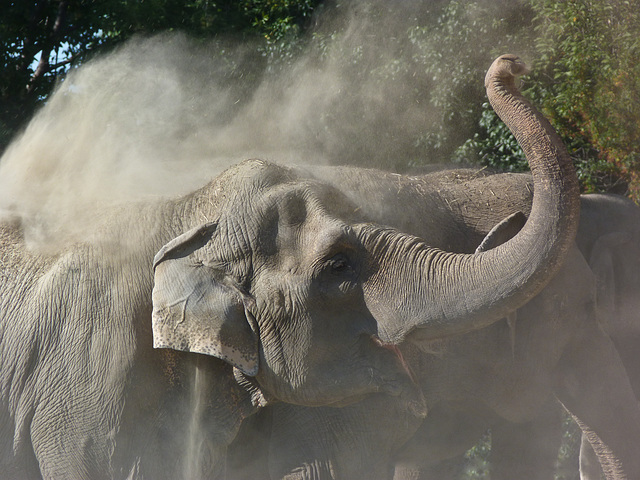Glowing
Puffballs
Shoo-fly / Nicandra physalodes
Little beacon of light
Shrimp Plant / Justicia brandegeeana
Yellowlegs
Painted Tongue / Salpiglosis
Gills
Gentiana
Young House Sparrow
Osprey with fish
Banded Orange / Dryadula phaetusa
Tarnished Plant Bug
Just a little cluster
Mock Strawberry / Potentilla indica
Columbine
: )
Flying from left to right - in case you can't tell…
Ligularia sp.
Tiger-striped Longwing / Heliconius ismenius telch…
Butter-and-eggs / Linaria vulgaris
Lichen
The tiniest mushrooms I ever saw : )
False Solomon's Seal berries / Maianthemum racemos…
.
Sainfoin / Onobrychis viciifolia
Have bread ... will share
A precious find
Northern Gentian / Gentianella amarella
Crab Spider on Goldenrod
Shadows and reflections
Yellow Clematis / Clematis tangutica
Some kind of fruit
Golden-mantled Ground Squirrel / Callospermophilus…
Paintbrush / Castilleja miniata
Mushrooms doing what mushrooms do
Endangered Snow Leopard / Uncia uncia or Panthera…
Maximilian Sunflower / Helianthus maximilianii
Coral Fungus
Water Lily
Yellow perfection
Strands of silk
Clasping-leaved Twisted-stalk berry / Streptopus a…
Red-belted Polypore and guttation
Collomia / Collomia linearis
Location
See also...
Keywords
Authorizations, license
-
Visible by: Everyone -
All rights reserved
-
149 visits
Enjoying a dust bath


Lol, a change from flowers, birds and fungi! Caught this Asian Elephant at the Calgary Zoo having a dust bath a couple of days ago. I've just read some interesting information on the Calgary Zoo website, link below.
"Asian elephants differ from their African cousins in that they have smaller ears, a less sloped back, only one 'finger' on their trunk, and the hind foot has 4 nails (rather than 3). Many think that the difference exists in their tusks (which are actually modified incisor teeth), since female Asian elephants appear not to have tusks. This is not true as female Asian elephants have tiny tusks under their trunk called tushes. It is also a misconception that all males have tusks because only about 20% of bulls actually do. These males are colloquially known as 'tuskers'.
Asian elephants rank as one of the smartest animals in the world and are capable of self-recognition. They live in herds of all females and their offspring is led by an elderly female called the matriarch. The females are usually related because females never leave the group that they are born into. Males get a little too rowdy for their parents during their teenage years. These teenage years roughly coincide with ours (12-14) because elephants have a similar lifespan of about 70 years.
There is a long history of elephants being hunted by humanity for meat, ivory, and domestication. The ivory trade continues to decimate wild populations, while their habitat is being destroyed for agriculture. Because of these factors, elephants have already disappeared from much of their former range (such as China)."
www.calgaryzoo.org/index.php?option=com_content&task=...
"Asian elephants differ from their African cousins in that they have smaller ears, a less sloped back, only one 'finger' on their trunk, and the hind foot has 4 nails (rather than 3). Many think that the difference exists in their tusks (which are actually modified incisor teeth), since female Asian elephants appear not to have tusks. This is not true as female Asian elephants have tiny tusks under their trunk called tushes. It is also a misconception that all males have tusks because only about 20% of bulls actually do. These males are colloquially known as 'tuskers'.
Asian elephants rank as one of the smartest animals in the world and are capable of self-recognition. They live in herds of all females and their offspring is led by an elderly female called the matriarch. The females are usually related because females never leave the group that they are born into. Males get a little too rowdy for their parents during their teenage years. These teenage years roughly coincide with ours (12-14) because elephants have a similar lifespan of about 70 years.
There is a long history of elephants being hunted by humanity for meat, ivory, and domestication. The ivory trade continues to decimate wild populations, while their habitat is being destroyed for agriculture. Because of these factors, elephants have already disappeared from much of their former range (such as China)."
www.calgaryzoo.org/index.php?option=com_content&task=...
- Keyboard shortcuts:
Jump to top
RSS feed- Latest comments - Subscribe to the comment feeds of this photo
- ipernity © 2007-2024
- Help & Contact
|
Club news
|
About ipernity
|
History |
ipernity Club & Prices |
Guide of good conduct
Donate | Group guidelines | Privacy policy | Terms of use | Statutes | In memoria -
Facebook
Twitter

Sign-in to write a comment.